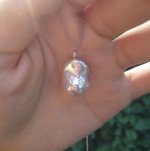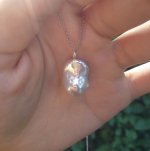You are using an out of date browser. It may not display this or other websites correctly.
You should upgrade or use an alternative browser.
You should upgrade or use an alternative browser.
Orient and freshadama/mettalic freshwater questions
- Thread starter Kpearl
- Start date
jshepherd
Pearl Paradise
Metallic refers to color.
Freshadama refers to Grading system, in this case by PP of its freshwater pearls that quality (luster, roundness, clean of blemishes) exceed AAA. Other vendors would refers by different terms -- Gem Grade, AAAA, Elite Collection, etc).
Hence, there are Freshadama freshwater pearls are in lavendor, white, metallic (more rare) etc
Metallic actually refers to luster typically with an undertone of color.
What differentiates freshadama is that we use loose grade pearls to make the line. In other words, we use pearls that are typically sold individually or by weight for use in earrings, pendants and other single-pearl pieces. We buy the pearls loose and have them drilled for strands. As far as I know, we're the only company in the world that does this with freshwater pearls on a large scale.
Without a standardized system, one company's AA+ could (and does) exceed standards for another's AAAA. There is typically one grade higher than "highest necklace grade" available at the shows from most of the large processors. This grade is often marketed as higher than AAA, but don't mistake it for AAAA. There are only a couple of companies using this designation and they sell at a price less than the wholesale cost of the higher grades - because there is no recognized, standardized system.
One easy way to gauge is in the sizing. Fine freshwater pearls under 9 mm are always measured in half millimeter sizes. In other words, they are 6-6.5 mm, 7-7.5 mm or 7.5-8 mm. They are never created in full millimeter increments, such as 6-7 mm, except in the larger sizes.
When sold in full millimeter increments, such as 7-8 mm, the smallest pearls will actually be as small as 6.5 mm at the ends, and the largest around 7.5 mm. Within the strand, approximately 75% of the pearls are in the smallest half and 25% in the larger. It's because the raw pearls are sold by weight. They're sometimes referred to as commercial grade.
Last edited:
Pearl Dreams
Pearl Enthusiast
hanadama, I dug up some photos and updated post #12. I could not locate the 3rd photo I originally used.
Metallic actually refers to luster typically with an undertone of color.
What differentiates freshadama is that we use loose grade pearls to make the line. In other words, we use pearls that are typically sold individually or by weight for use in earrings, pendants and other single-pearl pieces. We buy the pearls loose and have them drilled for strands. As far as I know, we're the only company in the world that does this with freshwater pearls on a large scale.
Without a standardized system, one company's AA+ could (and does) exceed standards for another's AAAA. There is typically one grade higher than "highest necklace grade" available at the shows from most of the large processors. This grade is often marketed as higher than AAA, but don't mistake it for AAAA. There are only a couple of companies using this designation and they sell at a price less than the wholesale cost of the higher grades - because there is no recognized, standardized system.
One easy way to gauge is in the sizing. Fine freshwater pearls under 9 mm are always measured in half millimeter sizes. In other words, they are 6-6.5 mm, 7-7.5 mm or 7.5-8 mm. They are never created in full millimeter increments, such as 6-7 mm, except in the larger sizes.
When sold in full millimeter increments, such as 7-8 mm, the smallest pearls will actually be as small as 6.5 mm at the ends, and the largest around 7.5 mm. Within the strand, approximately 75% of the pearls are in the smallest half and 25% in the larger. It's because the raw pearls are sold by weight. They're sometimes referred to as commercial grade.
Thank you Jeremy. This is very educational!
Sanippy
Member
Pearl Dreams
Pearl Enthusiast
I'm seeing both! 
Sanippy
Member
Pearl Dreams
Pearl Enthusiast
Sanippy
Member
Thanks Pearl Dreams! Wow that is one stunning pearl.
trulyviolet
New Member
that's a gorgeous pearl
lary007
Well-known member
Oooooh my. That pearl is killer!
Camelotshadow
Member
WOW! Beautiful & its hard to capture orient & overtones in pearls in photos. Thanks
I love orient esp purple & blues!!!!
I have seen orient on my pearls. Sadly on a 8.5mm pair of white pearl earrings that I sold that had a great elaborate prong design.
I love orient esp purple & blues!!!!
I have seen orient on my pearls. Sadly on a 8.5mm pair of white pearl earrings that I sold that had a great elaborate prong design.
amti
Community member
beautiful!
One easy way to gauge is in the sizing. Fine freshwater pearls under 9 mm are always measured in half millimeter sizes. In other words, they are 6-6.5 mm, 7-7.5 mm or 7.5-8 mm. They are never created in full millimeter increments, such as 6-7 mm, except in the larger sizes.
When sold in full millimeter increments, such as 7-8 mm, the smallest pearls will actually be as small as 6.5 mm at the ends, and the largest around 7.5 mm. Within the strand, approximately 75% of the pearls are in the smallest half and 25% in the larger. It's because the raw pearls are sold by weight. They're sometimes referred to as commercial grade.
Color me confused. Does commercial grade refer to bulk pearls sold by weight? Does that mean they have not yet been sorted by grade, or that they have been examined and fall below a certain quality threshold? Might one find AA+ and AAA pearls within a lot of commercial grade pearls? What, exactly, should the term "commercial grade" tell me about a pearl or a strand?
Thanks,
Ted
Pearl Dreams
Pearl Enthusiast
Commercial grade are lower grade pearls. No AA+ or AAA, no.
Icyjade
Member
- Joined
- Oct 6, 2014
- Messages
- 573
Commercial grade are lower grade pearls. No AA+ or AAA, no.
Is that the industry standard terminology? Because in discussions with a regular vendor that I buy from, he refers to most of the pearls at the shows as commercial grade. Based on what I see, many are AA+/AAA grade.
Pearl Dreams
Pearl Enthusiast
That's interesting icyjade...I've only ever heard the term used to refer to low grade pearls. What shows is he referring to? Surely not the Hong Kong show?
If that vendor considers AAA to be commercial grade, does he think anything that isn't gem is commercial? Or does he think the pearls in question were graded too high?
If that vendor considers AAA to be commercial grade, does he think anything that isn't gem is commercial? Or does he think the pearls in question were graded too high?
Katbran
Well-known member
Maybe he was referring to 'wholesale' ?? Bulk buying ? I can sort of see what he might mean..there are a whole bunch of pearl vendors at the HK show that sell low grade pearls. Lots of them. But then there are lots of good companies that have some low grade and then higher grades. To some degree you need something for everyone I suppose. Lots of 'fashion' jewellery/pearls that you see in gift shops are low grade.
Icyjade
Member
- Joined
- Oct 6, 2014
- Messages
- 573
Yup think the discussion was at a HK show but could be SG too... anyway he goes to both.
Maybe to provide some context, I was asking him about my wish list pearls and he was explaining that they are not easy to find. He then mentioned that the pearls I'm looking for is not the commercial grade that's common at the shows. This vendor mainly carries AAA/gem grade at shows I think.
As for low grades... are those mainly the HK and China vendors? There were loads of booths that I just mentally skipped over when I saw the stuff on display, and spent most of my time browsing at the Japan/overseas section. And for low grade ssps, I was actually looking for a strand of affordable circled Gssp at the HK show n didn't find a single strand. When I asked the same vendor why, he explained that it's not worth the transport cost for the vendors to bring in the lower quality pearls to the shows. So maybe that explains why most of the pearls I saw were AA+/AAA, I had mental blinkers on and never looked at the low grade pearls?
Maybe to provide some context, I was asking him about my wish list pearls and he was explaining that they are not easy to find. He then mentioned that the pearls I'm looking for is not the commercial grade that's common at the shows. This vendor mainly carries AAA/gem grade at shows I think.
As for low grades... are those mainly the HK and China vendors? There were loads of booths that I just mentally skipped over when I saw the stuff on display, and spent most of my time browsing at the Japan/overseas section. And for low grade ssps, I was actually looking for a strand of affordable circled Gssp at the HK show n didn't find a single strand. When I asked the same vendor why, he explained that it's not worth the transport cost for the vendors to bring in the lower quality pearls to the shows. So maybe that explains why most of the pearls I saw were AA+/AAA, I had mental blinkers on and never looked at the low grade pearls?
Pearl Dreams
Pearl Enthusiast
I can see why vendors may not want to pay to ship lower cost pearls to the show, but I don't equate lower price point with lower grade. There can be circled pearls that have high grade luster and surface, but they will cost less because the shapes are more common.
Similar threads
- Replies
- 8
- Views
- 2K



